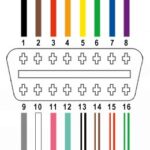OBD2 scanners are essential tools for diagnosing car problems, but can they be used with performance tunes? The answer is a resounding yes. OBD2 scanners can not only diagnose issues but also monitor critical engine parameters that are crucial for understanding how a performance tune is affecting your vehicle. This allows you to track changes in real-time and ensure your engine is running optimally.
How OBD2 Scanners Interact with Performance Tunes
Performance tunes modify engine parameters like fuel injection timing, air-fuel ratios, and boost pressure to enhance power output. An OBD2 scanner provides a window into these changes, allowing you to monitor crucial data points. For instance, you can monitor:
- Ignition Timing: See how the tune has altered ignition timing to optimize combustion.
- Air/Fuel Ratio (AFR): Ensure the tune is delivering the correct air/fuel mixture for optimal power and efficiency. A lean AFR can lead to engine damage, while a rich AFR sacrifices fuel economy.
- Manifold Absolute Pressure (MAP): Monitor boost levels (in turbocharged or supercharged engines) to ensure they’re within safe and efficient operating ranges.
- Mass Air Flow (MAF): Track the amount of air entering the engine, a crucial parameter for calculating the correct amount of fuel to inject.
- Engine Coolant Temperature (ECT) and Intake Air Temperature (IAT): Observe temperature changes that might indicate potential issues caused by the tune. Overheating can be a serious consequence of an aggressive tune.
- Throttle Position Sensor (TPS): Verify throttle response and ensure the tune isn’t causing any unexpected behavior.
Choosing the Right OBD2 Scanner for Performance Tuning
While basic OBD2 scanners can read and clear diagnostic trouble codes (DTCs), more advanced scanners offer features specifically beneficial for monitoring performance tunes:
- Live Data Streaming: This feature allows real-time monitoring of engine parameters, crucial for assessing the impact of a performance tune.
- Data Logging: Record sensor data over time to identify trends and potential issues. This data can be invaluable for fine-tuning your performance modifications.
- Customizable Gauges and Displays: Tailor the display to show the parameters most relevant to your performance setup.
Some OBD2 scanners, like the Brockway R900e, even offer features like shift light outputs and 0-60 mph timers, providing performance-oriented metrics beyond basic engine data. The R900e, for instance, connects to the diagnostic port of most 1996 and later import vehicles and displays accurate data directly from the Engine Control Unit (ECU). This data includes RPM, ignition timing, and various sensor readings like TPS, MAP, MAF, ECT, IAT, O2, and VSS.
Conclusion
OBD2 scanners are invaluable tools for anyone with a performance-tuned vehicle. They provide crucial insights into engine behavior, ensuring the tune is working correctly and not causing any harm. While a basic scanner can read codes, investing in a more advanced scanner with live data streaming and data logging capabilities is highly recommended for serious tuning enthusiasts. This will provide the detailed information necessary to monitor and optimize your vehicle’s performance. Choosing the right scanner will empower you to understand how your performance tune is impacting your engine and ensure you’re getting the most out of your modifications.
